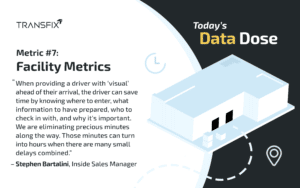Today’s Data Dose is an original Transfix series that helps shippers identify the key metrics they should track to get the most out of their supply chain. Which data measurements should an organization prioritize, considering their unique pain points, network, and goals?
We’ve got answers. We’ve got insights.

If your shipping facility were being reviewed on social media, would its combination of metrics merit five-star evaluations, or three? Facilities—large or small—have so many variables to assess that people sometimes forget to view them both individually and holistically. A good “everyday life” lens through which to holistically consider these metrics would be the near-universal process of deciding which restaurant to patronize. Any debate about the merits of either may involve the same concerns: “oh, they only have three spaces to park,” or “the staff is unhelpful,” or “too much exposure to the weather,” or “there are half a dozen other parties in line already.” These complications often add up, sometimes enough to make others declare that the establishment is poorly run.
Shippers, too, need to be realistic about physical or procedural issues that impact efficiency. Shippers can examine broad or specific facility behaviors—such as freight detention time, overtime, average performance of one dock versus another—and utilize that data to improve efficiency. For example, if Facility A has an average load time of three hours and Facility B has an average load time of one hour, what practices can be replicated in the underperforming facility?
“One important metric for facilities to understand is dwell time,” says Robert Treadwell, Senior Sales Effectiveness Manager at Transfix. Trailer dwell time is the amount of time that a trailer is left on-site. “This is often discussed along with detention and live unload—but with drop trailers, the operation and focus change a bit. When dealing with drop trailers, if a customer has very high dwell times, this could be a sign that the unloading operation is not as efficient as it should be.” This might also indicate that the facility is using trailers as additional inventory space or otherwise misallocating resources.
The guideline for drop trailer unloading is that it should generally not take longer than 24 hours. Treadwell elaborates: “If the trailer is held for an extensive period of time, carriers will often be disinterested in continuing business. Setting expectations and having clear communication about standard unloading can be very helpful for maintaining carrier relationships.”
Transfix’s Inside Sales Manager Stephen Bartalini addresses these problems from the perspective of partner organizations: “Outside parties can make suggestions, but we cannot control the shipper or consignee facility. We can, however, learn and understand how it looks and feels for a driver to enter, load/unload, and exit the facility—and, with this knowledge, we can determine a more efficient approach.”
Bartalini suggests that partner organizations should prepare ahead of time. For example, by requesting and reading through a facility’s SOP and proactively connecting with management—or with those who are physically at the loading docks, security gate, or elsewhere—any “speed bumps” a driver may encounter can be identified beforehand.
Bartalini explains: “When providing a driver with ‘visual’ ahead of their arrival, the driver can save time by knowing where to enter, what information to have prepared, who to check in with, and why it’s important. We are eliminating precious minutes along the way. Those minutes can turn into hours when there are many small delays combined.”
Will crunching facility numbers shine a light on problems, or on systems so efficient and praiseworthy that they ought to be replicated elsewhere? Does Facility A need recognition for a job well done, or a total overhaul of its loading bay procedures? Drivers may not have an opportunity to be forthcoming with their opinions, but the numbers don’t lie.
Does your organization need a carrier-side opinion on facility metrics? Click here to learn more about Transfix’s Intelligent Freight PlatformTM. And keep an eye out for our next Data Dose: #8, Freight Invoice Accuracy.




